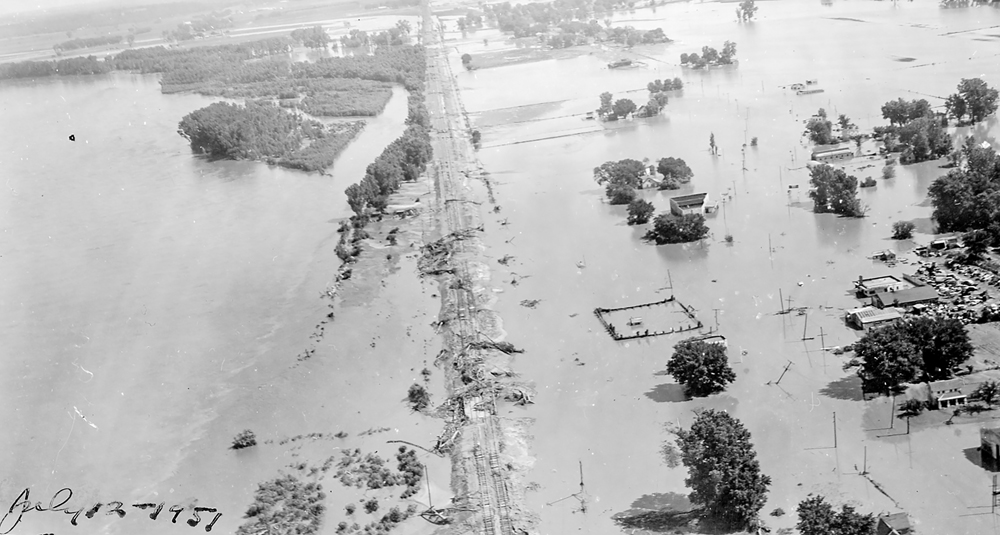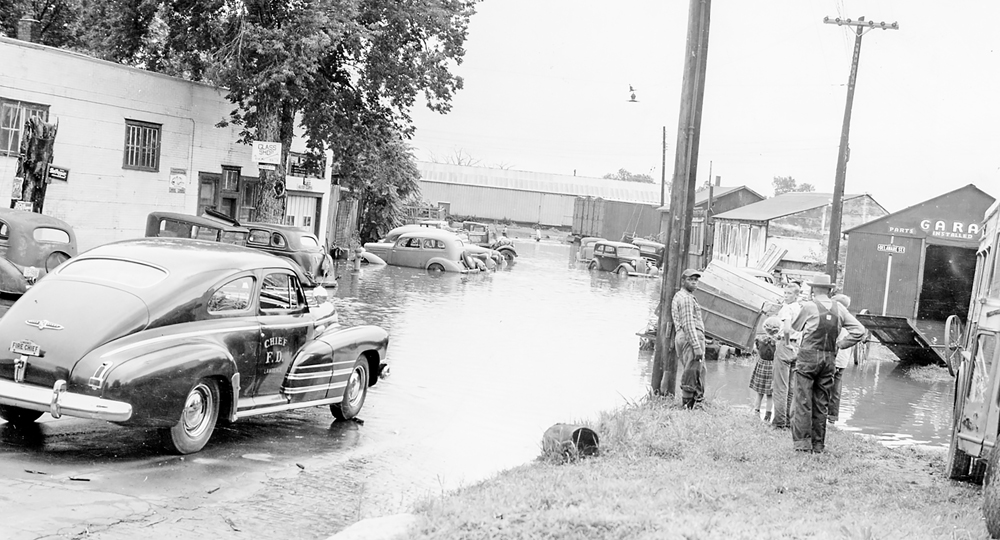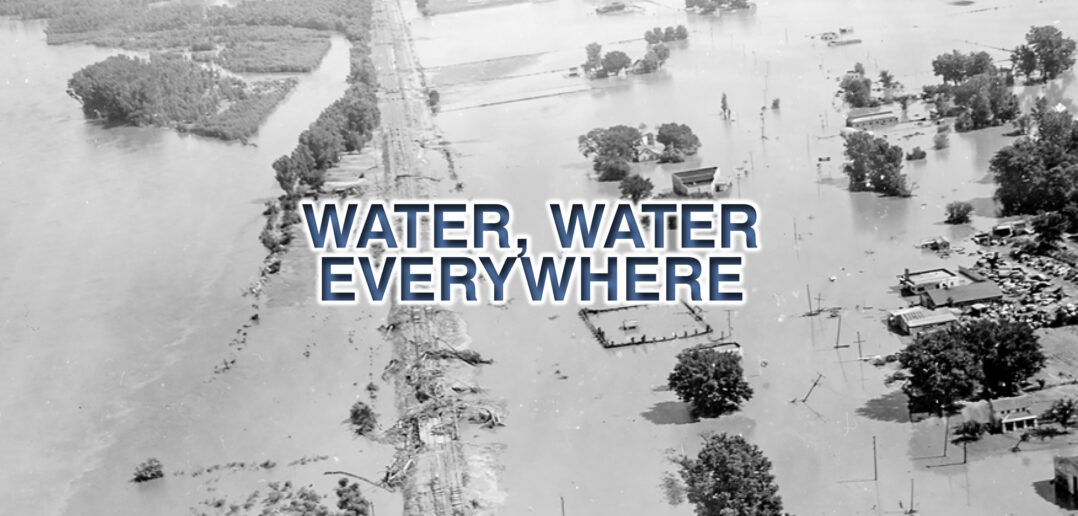| story by | |
| photos by | Steven Hertzog |
| OPEN A PDF OF THE ARTICLE |
The North Lawrence Flood of 1951 wreaked havoc on not just Lawrence but communities all along the Kansas River. Residents and businesses were displaced, and cleanup and restoration took months.

Breaks in the Union Pacific Levy- Looking north on the railway
Central and Eastern Kansas experienced enormous amounts of precipitation in the summer of 1951. The area received above-normal rainfall in May and June, which caused rivers and streams to be higher than normal, ground water levels high, and the ground so saturated it could not absorb additional rainfall. Heavy rains fell in July, making the situation even worse. The Kansas River and its tributaries were filled to their banks and overflowing into the flood plain. Total damage from the resulting floods included 45,000 homes destroyed or damaged, and 17 road and railroad bridges washed. Even though locomotives had been parked, several had to try and help keep them in place. More than 2 two million acres were flooded. The estimated total damage was $2.5 billion, and at 1952 prices, would have exceeded $17 billion using the rate for $2,000. The 1951 flood led to the construction of several flood-control reservoirs. However, given the confluence of circumstances that led to the flood, it is still possible that another flood, hopefully of lesser magnitude, could occur.
Lawrence was impacted by the 1951 flood, as were numerous communities along the Kansas River. North Lawrence suffered significant damage, and residents were urged to evacuate, with no exceptions, by Mayor Chris Kraft, of Lawrence. A loudspeaker truck from the University of Kansas (KU) warned residents to leave. People were asked to move their furniture to a second story if possible and turn off gas, lights and water when leaving their homes. The Lawrence National Guard oversaw the evacuation. By the time Lawrence Unit Company H was demobilized, the unit had been on flood duty for 11 days, 24 hours per day. Working with the Douglas County Sheriff’s Office, guard members handled patrolling assignments, evacuation duties and general guard duty. Douglas County Sheriff Travis praised the efforts of Company H:

Breaks in the Union Pacific Levy- Looking north on the railway
- The National Guard did a far better job than any other group that worked on the flood. They were on duty 24 hours a day, and they handled their responsibility with such efficiency that we were never at any time worried about law enforcement in stricken areas. Those boys were top, and we of the sheriff’s department feel that the community is deeply indebted to them.
An evacuation headquarters was established in the Chamber of Commerce building, and an emergency housing office was located in the Community Building. Those evacuating North Lawrence who had no family or friends to stay with in Lawrence were urged to report to the housing office. The plan was to house the evacuees in churches, schools and at Haskell University dormitories. Everyone in South Lawrence who had extra rooms were asked to call the emergency housing office. There was an urgent need for homes that could accommodate children.
LOCAL MATTERS
Our Local Advertisers – Making a Positive Impact
The American Legion in Lawrence and across the state began a “lend a hand” project to collect household supplies to donate to evacuated North Lawrence residents. The Lawrence Journal World printed the following on behalf of the Legion:
- Items to be given to persons who lost their belongings in the flood requested include sheets, pillow cases, bed covers, dresser scarves, women’s and children’s coats and jackets, shoes, socks, caps and hats, men’s and boy’s trousers, shirts, coats and jeans, and baby food, and canned vegetables and fruit. George Starkey, who was in charge distributing the donated items for the Dorsey-Liberty Post No. 14, urged folks to think of the distribution as a helping hand to neighbors, not charity.
Numerous business and industrial companies in North Lawrence were impacted by the flood. The Santa Fe Railroad in Lawrence was out of service until floodwaters receded from the tracks, and the Union Pacific was running a limited number of trains. The newspaper printed a list of state highways that were closed, which forced trucks bringing supplies to the city to take a circuitous route. Food trucks from Kansas City had to travel 150 miles to get to Lawrence, because parts of their regular routes were closed.
Westvaco Chemical plant, in North Lawrence, incurred an estimated $1 million in damage. It had only recently opened, costing $3½ million to build. Emil Podsiasio, plant manager, announced it would take at least a month and, most likely, two before the plant could resume production. The facility employed 85 people. Activity at the Sunflower Ordnance Works was limited to patrolling oil storage fields. Production was suspended until floodwaters receded. Several plant workers from South Lawrence stranded at the plant were returned across the waters by boat. The M. N. Penny Ready-Mix Concrete Co. was closed for 10 days while employees worked to clear mud and repair damage to the large mixing plant. Damages were estimated at approximately $15,000. The company could produce 300 yards of mixed concrete per day. Once production resumed, its concrete would be essential in the rehabilitation of streets in North Lawrence.

Cohen’s on 9th St near Santa Fe switches showing water afternoon July 12 after flood had broken dykes that morning and water high had attained about 28.5 feet.
A number of North Lawrence small businesses also suffered damage, most of it to inventory stored in basements. Fritzel-Jayhawk Dairy lost more than $5,000 worth of milk jugs and cartons that were stored in the basement of the Royal College Shop. Montgomery Ward used two jet pumps to keep its basement, limiting damage to items stored there. Stowitts Rexall Drug Store had 12 inches of water in its basement, but most of the merchandise was stored above floor level, so there was minimal impact to its inventory. Twelve inches of water caused little destruction to items stored in Woolworth’s basement. Cole’s Food Market’s new brick building had swiftly flowing water breaking its plate glass window. The flood water reached the height of the ceiling, and three-quarters of the south wall crumbled, as well as part of the roof.
The flooding created problems for a number of public services. Streets in North Lawrence had mud standing in gutters and covering sidewalks, but the speed of the water streaming through the roadbeds left them relatively clean. Phone service was disrupted for approximately 675 residences and businesses. Two power line structures that were part of the infrastructure that carried a 66,000-volt line from Lawrence to Leavenworth were down. Another electrical line that carried power from Tonganoxie, Lawrence and Bonner Springs was also down. The Lawrence-Douglas County health department sprayed most of North Lawrence with DDT, an insecticide used in agriculture. Water service was restored slowly, with a warning to residents to boil all water used for drinking, cooking and dishwashing.
Dr. H. R. Wagenblast, the director of the health department, gave numerous instructions to people returning to their home:
- Dr Wagenblast says that after removal of mud and silt from a building, the entire interior which has been under flood water should be thoroly (sic.) scrubbed with soapy water. Following this, the same area should be disinfected with a chloring solution, such as Clorox or Purex.
Structures had to be inspected by electricians and other inspectors before gas and electricity could be turned on. This included all wiring, switches, motors and other household electrical appliances. Any wiring that had been underwater had to dry out and be cleaned before inspectors could give permission to have services restored.
In working to return their homes and businesses to normal, North Lawrence residents had to deal with much more than just “water in the basement.” They had to find someplace to live in the interim. It took weeks and months to clean up mud and silt, to restore utilities to working order and to repair damage to homes and businesses. Many people in Lawrence and across Kansas donated a variety of needed supplies. Other communities that were flooded nearby also had to deal with the issues faced by North Lawrence.




